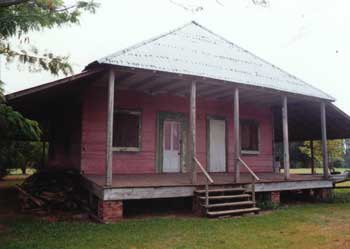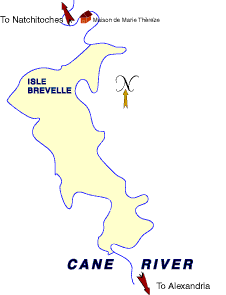Maison de Marie Thérèse
Cane River Creole community members trace their heritage to Marie Thérèse "Coin Coin" and Claude Thomas Pierre Metoyer. Marie Thérèse was a slave of undetermined ethnicity belonging to the St. Denis family, and Metoyer was the French colonist who purchased and later manumitted her and their ten children. Marie Thérèse and her descendants became important colonial plantation owners and were responsible for the construction of several of the most architecturally significant structures in the community.

They said this was her house, all the older people.
Built c. 1786, this Creole raised cottage is on the site of the indigo plantation established by Marie Thérèse on her Spanish land grant. It was constructed of hewn frame poteaux-sur-solles with corner faces and paneled bousillage, topped by a hipped roof. The floor boards and wood plank ceilings are original to the house. The exterior is sheathed in irregularly placed beaded boards, which were added sometime after the house was built, as was the colorful paint. The house is unusual for the region and time period in that it does not face the river.
That's where they say she got sick [before] her son went to get her.
Local history suggests that Marie Thérèse lived out her final days at the home of her son, Louis Metoyer, at the plantation we now know as Melrose. It is believed that at that time, his primary residence was almost directly opposite the river from where the big house at Melrose is now located, but Melrose was not constructed until 1833.
Maison de Marie Thérèse is owned by a descendant of Claude T. P. Metoyer and Marie Thérèse "Coin Coin." Because of the architectural and historical significance of this structure, it is listed on the National Register of Historic Places.
